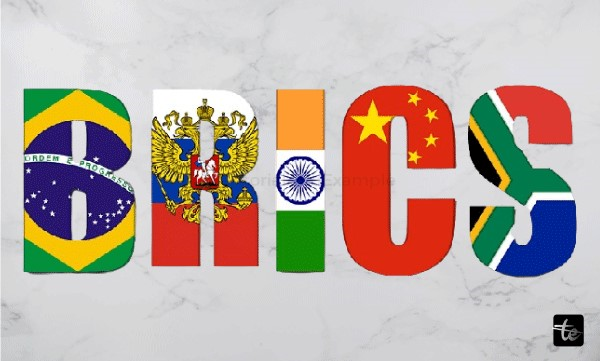BRICS Full Form
Introduction:
Brazil, Russia, India, China, and South Africa are members of the international group known as BRICS. It was created in 2010 when South Africa was added to the BRIC group which preceded it. President Cyril Ramaphosa of South Africa revealed at the 15th BRICS Summit in August 2023 that invitations to join the organization had been extended to Argentina, Egypt, Ethiopia, Iran, Saudi Arabia, and the United Arab Emirates. It is anticipated that Argentina's current administration will turn down the offer. The first day of full association membership is January 1, 2024.
Currently, 42% of the world's population lives in the BRICS countries, which make up around 27% of the planet's land area. Among the top ten biggest nations in the globe in terms of people, area, and GDP (PPP) are Brazil, Russia, India, and China. With an overall nominal annual GDP of US$28 trillion (about 27% of the gross world product), an overall GDP (PPP) of approximately US$57 trillion (33% of the global GDP PPP), and a projected US$4.5 trillion in cumulative foreign reserves (as of 2018), all five countries are among the G20.

The BRICS were not a recognized international body when they were first formed; they were chosen to highlight the investment potential. Their leaders have been meeting yearly at official conferences and coordinating multilateral policies as they have gradually become a more coherent geopolitical bloc since 2009. The three primary tenets of BRICS bilateral relationships are equality, non-interference, and mutual benefit.
With initiatives like the National Development Bank, the BRICS Contingent Reserve Arrangement, the BRICS payments system, the BRICS Joint Statistics Publication, and the BRICS basket reserve currency, the BRICS countries are regarded as the G7's main geopolitical rivals. The group has been working to increase its membership since 2022, and several developing nations have expressed interest in doing so. A wide range of observers have praised and criticized BRICS.
History
The BRIC countries:
When the term "BRIC" was first coined, foreign investment methods were considered. Jim O'Neill, the CEO of Goldman Sachs Asset Management at the time, proposed it in the 2001 book Building Better Global Economy BRICs.
Starting a series of high-level meetings, the foreign ministers of the first four BRIC General nations (Brazil, Russia, India, and China) convened in September of 2006 in New York City on the fringes of the UN Assembly's General Debate. On June 16, 2009, a comprehensive diplomatic summit occurred in Yekaterinburg, Russia.
The leaders of Brazil, Russia, India, and China, Luiz atácio Lula da Silva, Dmitry Medvedev, Manmohan Singh, and Hu Jintao, attended the first official summit of the BRIC grouping, which was also held at Yekaterinburg on June 16, 2009. The summit's main agenda included strengthening the banking system and the state of the world economy, and future cooperative strategies among the four nations.
More conversation focused on how emerging nations—which comprise three-quarters of the BRIC countries—might raise their profile in international affairs.
Following the 2009 Yekaterinburg conference, the BRIC countries declared that a new worldwide currency of reserve was required and that it must be "diverse, stable, and predictable." The declaration that was made caused the value of the US dollar to decline relative to other significant currencies, even though it did not specifically denounce the alleged "dominance" of the US currency—something that Russia had previously criticized.
South Africa Joins the BRICS:
South Africa started pursuing membership in the BRIC countries in 2010, and in August of the same year, the official admissions process got underway.
On December 24, 2010, South Africa formally joined the BRIC countries, having first been invited to join by China and then being approved. The organization was renamed BRICS to reflect its increased membership, with the "S" representing South Africa. As a full member, South Africa's President Jacob Zuma addressed the 2011 BRICS meeting in Sanya, China, in April 2011.
Bank for New Development:
Presidents Jair Bolsonaro of Brazil and Vladimir Putin of Russia during the BRICS meeting in Brasília, Brazil.
The BRICS countries committed $75 billion in June 2012 to increase the International Monetary Fund's (IMF) lending capacity. This loan was contingent on IMF voting reforms, though. At the sixth BRICS summit in Durban, South Africa, in March 2013, the member nations decided to establish a worldwide financial institution to work alongside the World Bank and IMF, which the West dominates. By 2014, they intended to establish this New Development Bank. However, disagreements over location and burden allocation caused the contracts to stall.
Procedure for Applications:
Up through the early 2020s, there was minimal discussion regarding the group's growth and admission of new members. However, leaders and senior diplomats of the foundation countries started talking about the organization's development after this date.
To be invited, a prospective country must obtain the support of all current BRICS members—Brazil, Russia, India, China, and South Africa.
The BRICS Contingent Reserve Plan
Additional details: The BRICS Contingent Reserve Plan
A mechanism called the BRICS Contingency Reserve Arrangements (CRA) is intended to offer defence against pressures on global liquidity. This includes currency problems where demands from the global financial system negatively impact members' home currencies.
Rapid liberalization of the economy in developing nations resulted in higher economic volatility and an unstable macroeconomic environment. The International Monetary Fund (IMF) and the CRA are rivals. It is an example of growing South-South collaboration alongside the New Development Bank. It was founded by the BRICS nations in 2015. The Agreement for the Creation of a BRICS Contingent Reserve Structure agreed on in Fortaleza in July 2014, provides the legal framework. The BRICS CRA came into being on September 4, 2015, in Ankara, Turkey, with the first meetings of its governing council and Standing Committee. It was revealed at the 7th BRICS meeting in July 2015, and every BRICS state ratified it.l